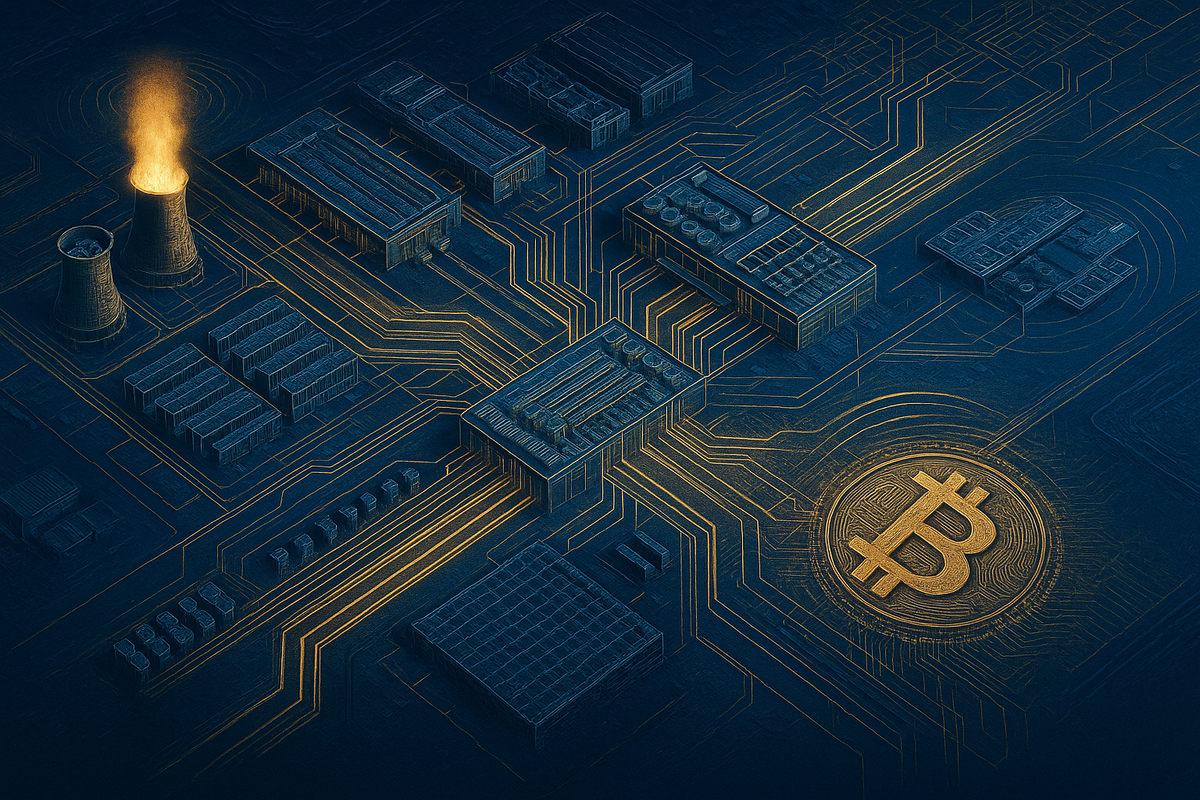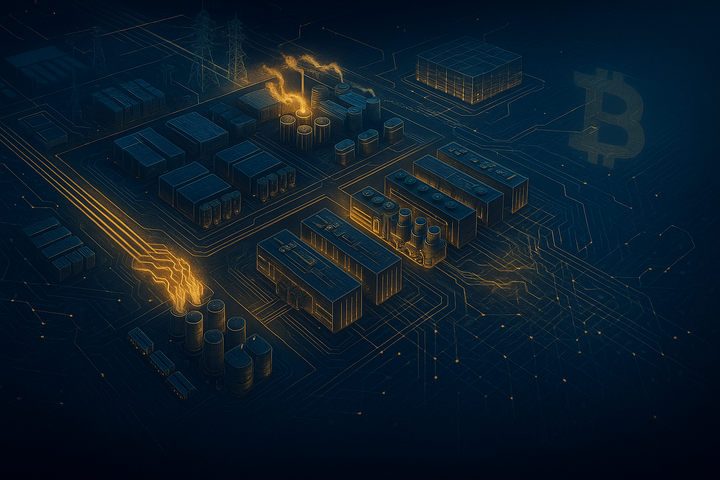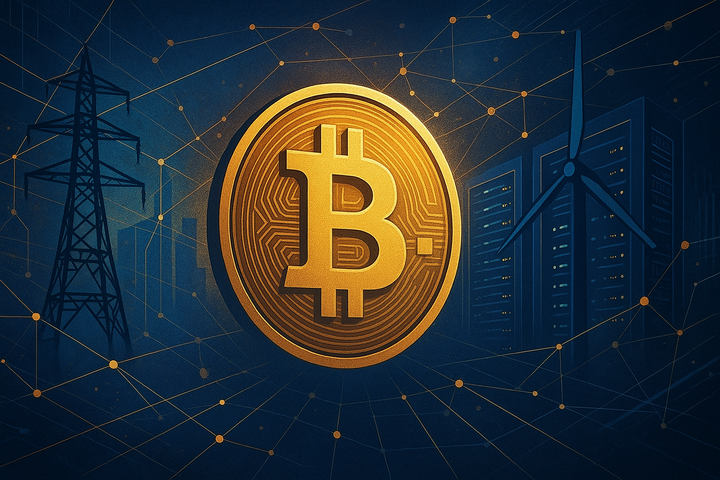Bitcoin, AI, and Power Scarcity: Utilities, Curtailment, and the Next Rotation
The October 05, 2025 episode of the Jordi Visser Podcast features Jordi arguing that electricity, not GPUs, is now the binding constraint on AI deployment.

- My 'briefing notes' summarize the content of podcast episodes; they do not reflect my own views.
- They contain (1) a summary of podcast content, (2) potential information gaps, and (3) some speculative views on wider Bitcoin implications.
- Pay attention to broadcast dates (I often summarize older episodes)
- Some episodes I summarize may be sponsored: don't trust, verify, if the information you are looking for is to be used for decision-making.
Summary
The October 05, 2025 episode of the Jordi Visser Podcast features Jordi arguing that electricity, not GPUs, is now the binding constraint on AI deployment. Visser links turbine and transformer shortages, interconnect delays, and permitting friction to slower data-center rollouts while presenting Bitcoin mining as flexible load that stabilizes grids. He ties these mechanics to a likely rotation toward utilities and select small caps and frames Bitcoin as a clean macro expression of the AI-power regime.
Take-Home Messages
- Power is scarce: AI growth hits electricity limits before compute limits, shifting focus to generation and grid equipment.
- Bottlenecks drive timing: Turbines, transformers, and interconnect queues pace build-outs more than chip shipments.
- Flexible load is strategic: Bitcoin mining can curtail quickly, monetize surplus, and enhance grid reliability metrics.
- Flows and policy matter: Rate cuts, retail leadership, and permitting reforms shape deployment speed and winners.
- Rotation risk is real: Utilities and select small caps stand to benefit as markets reprice power as the gating factor.
Overview
Jordi Visser argues that AI demand is exponential while supply planning in semiconductors and power remains largely linear. He contends that headline oversupply narratives ignore sustained inference workloads and the slower cadence of grid expansions. The result, in his view, is a mispricing of where the true constraint sits.
Visser relocates the bottleneck from compute to energy by emphasizing turbines, transformers, and interconnects as the critical chokepoints. Long equipment lead times and permitting delays push new capacity to the right even when capital is available. This dynamic elevates utilities and grid manufacturers as central actors in the next capex cycle.
Within this frame, Visser presents Bitcoin mining as programmable, fast-curtailing demand that supports reliability and improves project bankability. Miners absorb off-peak generation, then stand down during scarcity to aid system stability. He links this to better utilization of intermittent or stranded resources.
He closes by connecting macro conditions and investor positioning, noting calmer vol and supportive odds of rate cuts without a hard-landing. Retail flows have moved faster than cautious institutions, creating a timing gap in AI-energy exposures. Visser concludes that Bitcoin expresses the AI-power thesis cleanly because it sits at the intersection of energy monetization and network effects.
Stakeholder Perspectives
- Grid Operators: Prioritize reliability; value fast-curtailing loads that stabilize frequency and reduce peak stress.
- Utilities: Seek rate-base growth across generation, wires, and transformers while aligning demand partners to manage peaks.
- Energy Developers: Want colocated offtake and curtailment contracts that de-risk financing and accelerate interconnections.
- Institutional Investors: Reassess utilities, equipment makers, and demand-response assets as beneficiaries of power scarcity.
- Bitcoin Miners: Pursue grid-integrated designs and tariffs that monetize flexibility without triggering policy backlash.
Implications and Future Outlook
Power scarcity will dictate AI deployment schedules, forcing investors and operators to prioritize electricity access ahead of chip supply. Stakeholders that standardize curtailment contracts and storage hybrids will gain an execution edge. Transparent designs that share reliability value with consumers will reduce policy friction.
Markets are likely to reward utilities with credible build plans and suppliers with visible backlogs. Demand-response operators able to verify reliability contributions will capture premium economics. Semiconductor and data-center roadmaps will increasingly price electricity constraints into every scale decision.
If rate cuts proceed without recession, capital will flow toward power-linked names while institutions close underweights. Community acceptance will hinge on siting practices, water use, and noise mitigation near industrial loads. Clear reporting on curtailment performance and consumer benefits will shape permitting outcomes.
Some Key Information Gaps
- Which power infrastructure investments most efficiently relieve near-term AI bottlenecks at utility scale? Policymakers and investors need comparative cost-benefit evidence to target capital and permitting reforms.
- Under what grid conditions do Bitcoin miners deliver net societal value through curtailment and revenue stacking? Regulators require measurable reliability and consumer-price impacts to calibrate tariffs and approvals.
- What earnings and valuation frameworks best capture utility upside from AI-driven power scarcity? Consistent methods are needed for rate-case planning, capital formation, and cross-jurisdiction comparison.
- How should semis and High Bandwidth Memory (HBM) suppliers recalibrate capacity planning models to reflect exponential AI demand? Better demand modeling reduces misallocation and aligns fab expansion with power-constrained deployments.
- What mechanisms link Bitcoin’s price to power scarcity, miner curtailment revenues, and network effects? Clear channels improve portfolio construction and inform policy on grid-integrated mining..
Broader Implications for Bitcoin
Electrification as the new compute moat
As AI competition intensifies, guaranteed access to reliable, affordable power becomes a defensible advantage. Regions that align permitting, interconnects, and equipment supply chains will capture outsized data-center and manufacturing investment. Bitcoin’s grid-integrated mining can act as a portable demand balancer that helps jurisdictions translate intermittent generation into durable industrial moats.
Utility business models shift toward flexibility services
Traditional volumetric sales give way to value from reliability, fast ramping, and capacity availability. Utilities that monetize flexible demand and storage alongside wires upgrades will anchor the AI era’s rate base. Bitcoin miners that verifiably deliver curtailment become partners in these new service stacks rather than purely energy consumers.
Capital rotation rewires market leadership
If power is the gating input, leadership shifts from pure compute to asset-heavy power ecosystems. Equipment makers with transformer and turbine backlogs, and utilities with credible build plans, become core holdings. Bitcoin exposure functions as a macro hedge on power scarcity and as an index on the build-out’s cadence.
Policy prioritizes grid resilience over headline megawatts
Outcomes depend less on nameplate capacity and more on controllability, siting, and interconnection quality. Regulators will favor projects that document curtailment performance, consumer benefits, and environmental safeguards. Bitcoin-enabled demand response fits this policy arc by converting surplus generation into measurable reliability value.
Workforce and regional development realign
Power-centric build-outs drive skilled-trade demand in transmission, generation, and controls. Regions that integrate training pipelines and streamlined approvals will scale faster and retain investment. Bitcoin mining clusters colocated with renewables can anchor industrial parks that share infrastructure and labor pools.



Comments ()